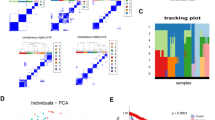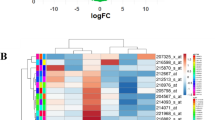Abstract
Purpose
Predicting the prognosis in laryngeal squamous cell carcinoma (LSCC) patients will improve clinical decision-making. Here, we aimed to identify a qualitative signature based on the within-sample relative expression orderings (REOs) of microRNA (miRNA) pairs to predict the overall survival (OS) of LSCC patients.
Methods
First, we constructed non-repeating miRNA pairs based on differentially expressed miRNAs (DEmiRNAs) between LSCC and normal tissues. Then, we applied a bootstrap-based feature selection method to identify a robust miRNA-pair signature. The bootstrap-based feature selection improved the stability of feature selection by an ensemble based on the data perturbation. Furthermore, a series of bioinformatics analyses were carried out to explore the potential mechanisms of the signature and potential drug targets for LSCC.
Results
Based on the REOs of miRNA pairs, we identified a qualitative signature that consisted of 12 miRNA pairs. The constructed signature has good performance in predicting the OS of LSCC patients. It is robust against batch effects and more suitable for individual clinical applications. Furthermore, we identified several hub genes that may be potential drug targets for LSCC.
Conclusion
Overall, our findings provided a promising signature for predicting the OS of LSCC patients.









Similar content being viewed by others
Availability of data and materials
The datasets of this article are available in the TCGA database.
References
Genden EM, Ferlito A, Silver CE, Jacobson AS, Werner JA, Suarez C, Leemans CR, Bradley PJ, Rinaldo A (2007) Evolution of the management of laryngeal cancer. Oral Oncol 43(5):431–439. https://doi.org/10.1016/j.oraloncology.2006.08.007
Obid R, Redlich M, Tomeh C (2019) The treatment of laryngeal cancer. Oral Maxillofac Surg Clin North Am 31(1):1–11. https://doi.org/10.1016/j.coms.2018.09.001
Spector ME, Rosko AJ, Birkeland AC (2018) Challenges in addressing early stage laryngeal squamous cell carcinoma. Transl Cancer Res 7(6):1338–1340. https://doi.org/10.21037/tcr.2018.09.10
Marioni G, Marchese-Ragona R, Cartei G, Marchese F, Staffieri A (2006) Current opinion in diagnosis and treatment of laryngeal carcinoma. Cancer Treat Rev 32(7):504–515. https://doi.org/10.1016/j.ctrv.2006.07.002
Steuer CE, El-Deiry M, Parks JR, Higgins KA, Saba NF (2017) An update on larynx cancer. CA Cancer J Clin 67(1):31–50. https://doi.org/10.3322/caac.21386
Hammond SM (2015) An overview of microRNAs. Adv Drug Deliv Rev 87:3–14. https://doi.org/10.1016/j.addr.2015.05.001
Garzon R, Calin GA, Croce CM (2009) MicroRNAs in cancer. Annu Rev Med 60:167–179. https://doi.org/10.1146/annurev.med.59.053006.104707
Farazi TA, Spitzer JI, Morozov P, Tuschl T (2011) miRNAs in human cancer. J Pathol 223(2):102–115. https://doi.org/10.1002/path.2806
Tian L, Zhang J, Ge J, Xiao H, Lu J, Fu S, Liu M, Sun Y (2014) MicroRNA-205 suppresses proliferation and promotes apoptosis in laryngeal squamous cell carcinoma. Med Oncol 31(1):1–10. https://doi.org/10.1007/s12032-013-0785-3
Shen Z, Zhan G, Ye D, Ren Y, Cheng L, Wu Z, Guo J (2012) MicroRNA-34a affects the occurrence of laryngeal squamous cell carcinoma by targeting the antiapoptotic gene survivin. Med Oncol 29(4):2473–2480. https://doi.org/10.1007/s12032-011-0156-x
Fountzilas E, Kotoula V, Angouridakis N, Karasmanis I, Wirtz RM, Eleftheraki AG, Veltrup E, Markou K, Nikolaou A, Pectasides D (2013) Identification and validation of a multigene predictor of recurrence in primary laryngeal cancer. PLoS ONE 8(8):e70429. https://doi.org/10.1371/journal.pone.0070429
Gong S, Xu M, Zhang Y, Shan Y, Zhang H (2020) The prognostic signature and potential target genes of six long non-coding RNA in laryngeal squamous cell carcinoma. Front Genet 11:413. https://doi.org/10.3389/fgene.2020.00413
Geman D, d’Avignon C, Naiman DQ, Winslow RL (2004) Classifying gene expression profiles from pairwise mRNA comparisons. Stat Appl Genet Mol Biol. https://doi.org/10.2202/1544-6115.1071
Gulgezen G, Cataltepe Z, Yu L (2009) Stable and accurate feature selection. In: Joint European conference on machine learning and knowledge discovery in databases. Springer
He Z, Yu W (2010) Stable feature selection for biomarker discovery. Comput Biol Chem 34(4):215–225. https://doi.org/10.1016/j.compbiolchem.2010.07.002
Student S, Fujarewicz K (2012) Stable feature selection and classification algorithms for multiclass microarray data. Biol Direct 7(1):1–20. https://doi.org/10.1186/1745-6150-7-33
Ritchie ME, Phipson B, Wu D, Hu Y, Law CW, Shi W, Smyth GK (2015) limma powers differential expression analyses for RNA-sequencing and microarray studies. Nucleic Acids Res 43(7):e47–e47. https://doi.org/10.1093/nar/gkv007
Stel VS, Dekker FW, Tripepi G, Zoccali C, Jager KJ (2011) Survival analysis I: the Kaplan–Meier method. Nephron Clin Pract 119(1):c83–c88. https://doi.org/10.1159/000324758
Dietrich S, Floegel A, Troll M, Kühn T, Rathmann W, Peters A, Sookthai D, Von Bergen M, Kaaks R, Adamski J (2016) Random Survival Forest in practice: a method for modelling complex metabolomics data in time to event analysis. Int J Epidemiol 45(5):1406–1420. https://doi.org/10.1093/ije/dyw145
Tibshirani R (1997) The lasso method for variable selection in the Cox model. Stat Med 16(4):385–395. https://doi.org/10.1002/(sici)1097-0258(19970228)16:4%3c385::aid-sim380%3e3.0.co;2-3
Kleinbaum DG, Klein M (2012) Kaplan–Meier survival curves and the log-rank test. Survival analysis. Springer
Subramanian A, Tamayo P, Mootha VK, Mukherjee S, Ebert BL, Gillette MA, Paulovich A, Pomeroy SL, Golub TR, Lander ES (2005) Gene set enrichment analysis: a knowledge-based approach for interpreting genome-wide expression profiles. Proc Natl Acad Sci USA 102(43):15545–15550. https://doi.org/10.1073/pnas.0506580102
Yu G, Wang L-G, Han Y, He Q-Y (2012) clusterProfiler: an R package for comparing biological themes among gene clusters. OMICS 16(5):284–287. https://doi.org/10.1089/omi.2011.0118
Guan Q, Chen R, Yan H, Cai H, Guo Y, Li M, Li X, Tong M, Ao L, Li H (2016) Differential expression analysis for individual cancer samples based on robust within-sample relative gene expression orderings across multiple profiling platforms. Oncotarget 7(42):68909. https://doi.org/10.18632/oncotarget.11996
Cheng J, Guo Y, Gao Q, Li H, Yan H, Li M, Cai H, Zheng W, Li X, Jiang W (2017) Circumvent the uncertainty in the applications of transcriptional signatures to tumor tissues sampled from different tumor sites. Oncotarget 8(18):30265. https://doi.org/10.18632/oncotarget.15754
Charette DM, Marabelle A, Houot R (2016) Turning tumour cells into antigen presenting cells: the next step to improve cancer immunotherapy? Eur J Cancer 68:134–147. https://doi.org/10.1016/j.ejca.2016.09.010
Lee MY, Jeon JW, Sievers C, Allen CT (2020) Antigen processing and presentation in cancer immunotherapy. J Immunother Cancer. https://doi.org/10.1136/jitc-2020-001111
Wang S, He Z, Wang X, Li H, Liu X-S (2019) Antigen presentation and tumor immunogenicity in cancer immunotherapy response prediction. Elife 8:e49020. https://doi.org/10.7554/eLife.49020
Rodriguez-Antona C, Ingelman-Sundberg M (2006) Cytochrome P450 pharmacogenetics and cancer. Oncogene 25(11):1679–1691. https://doi.org/10.1038/sj.onc.1209377
Mittal B, Tulsyan S, Kumar S, Mittal RD, Agarwal G (2015) Cytochrome P450 in cancer susceptibility and treatment. Adv Clin Chem 71:77–139. https://doi.org/10.1016/bs.acc.2015.06.003
Noël A (2012) New and paradoxical roles of matrix metalloproteinases in the tumor microenvironment. Front Pharmacol 3:140. https://doi.org/10.3389/fphar.2012.00140
Acknowledgements
We acknowledge the TCGA database for providing their platforms and contributors for uploading their meaningful datasets.
Funding
This study is funded by Sanming Project of Medicine in Shenzhen (SZSM201812062 and SZSM201612097).
Author information
Authors and Affiliations
Contributions
SZ conceived and designed the study. SZ performed the computations. SZ, QM and ZW wrote the manuscript. All the authors contributed to the final version of the manuscript. All authors have read and agreed to the published version of the manuscript.
Corresponding author
Ethics declarations
Conflict of interest
The authors declare that they have no competing interests.
Ethics approval and consent to participate
Not applicable.
Consent for publication
Not applicable.
Additional information
Publisher's Note
Springer Nature remains neutral with regard to jurisdictional claims in published maps and institutional affiliations.
Supplementary Information
Below is the link to the electronic supplementary material.
Rights and permissions
About this article
Cite this article
Zhou, S., Meng, Q. & Wang, Z. Prognostic value of a microRNA-pair signature in laryngeal squamous cell carcinoma patients. Eur Arch Otorhinolaryngol 279, 4451–4460 (2022). https://doi.org/10.1007/s00405-022-07404-9
Received:
Accepted:
Published:
Issue Date:
DOI: https://doi.org/10.1007/s00405-022-07404-9




